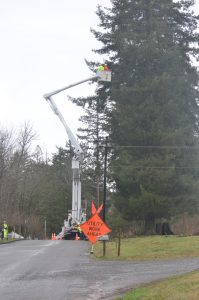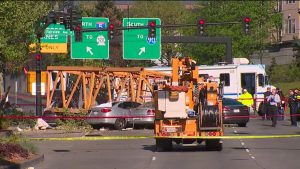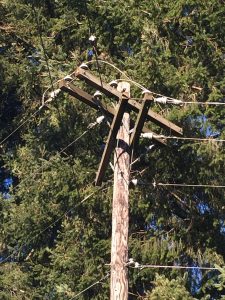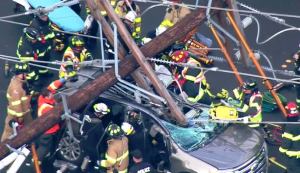 According to the Occupational Safety and Health Administration (OSHA), electrocutions are the third highest cause of construction worker deaths. Many electrical injuries and fatalities occur after a crane comes into contact with a powerline and the electrical current travels through the crane to the operator of the equipment. In order to help prevent these accidents from ever occurring, OSHA created extensive construction workplace safety rules for the operation of cranes and booms operating near powerlines. (29 C.F.R. 1926.1408).
According to the Occupational Safety and Health Administration (OSHA), electrocutions are the third highest cause of construction worker deaths. Many electrical injuries and fatalities occur after a crane comes into contact with a powerline and the electrical current travels through the crane to the operator of the equipment. In order to help prevent these accidents from ever occurring, OSHA created extensive construction workplace safety rules for the operation of cranes and booms operating near powerlines. (29 C.F.R. 1926.1408).
Under the OSHA regulation, before beginning equipment operations an employer must complete a number of steps. First, the employer must identify the work zone. The employer can either mark off the boundaries and prohibit equipment operators from going beyond the marked boundaries, or the employer can define the work zone as 360 degrees around the equipment up to the maximum working radius.
If any part of the construction equipment could get closer than 20 feet to a powerline within the identified work zone, the employer must take additional steps and complete one of the following options:
 Seattle Injury Lawyer Blog
Seattle Injury Lawyer Blog









 A construction crane collapsed from the roof of a building on Saturday afternoon tragically killing four people and injuring four others. Two of the people killed were ironworkers and two others were bystanders. The crane was positioned on the new Google Seattle campus and was in the process of being dismantled when it fell.
A construction crane collapsed from the roof of a building on Saturday afternoon tragically killing four people and injuring four others. Two of the people killed were ironworkers and two others were bystanders. The crane was positioned on the new Google Seattle campus and was in the process of being dismantled when it fell.
 A fun day out on the water could turn into a fatal accident, if the mast of your sailboat comes into contact with a low electrical line. In order to keep the public safe, the National Electrical Safety Code (NESC) publishes clearance requirements for electrical lines that hang over bodies of water.
A fun day out on the water could turn into a fatal accident, if the mast of your sailboat comes into contact with a low electrical line. In order to keep the public safe, the National Electrical Safety Code (NESC) publishes clearance requirements for electrical lines that hang over bodies of water. A downed electrical line coming into contact with a building or person can result in electrical shock or fire. In order to protect buildings and the occupants inside them from injury or death, the National Electrical Safety Code (NESC) created clearance regulations for electrical lines that hang over or run next to buildings.
A downed electrical line coming into contact with a building or person can result in electrical shock or fire. In order to protect buildings and the occupants inside them from injury or death, the National Electrical Safety Code (NESC) created clearance regulations for electrical lines that hang over or run next to buildings. On Friday April 5th, 26 utility poles fell on East Marginal Way in South Tukwila around 3:50pm. One Seattle couple is thankful to survive after one of the poles smashed through the windshield of their car trapping them inside. Luckily, the couple, Tom and Linda Cook, only suffered minor cuts and bruises.
On Friday April 5th, 26 utility poles fell on East Marginal Way in South Tukwila around 3:50pm. One Seattle couple is thankful to survive after one of the poles smashed through the windshield of their car trapping them inside. Luckily, the couple, Tom and Linda Cook, only suffered minor cuts and bruises. Electrical lines over roads can cause serious injury if a person, truck, or extension ladder come into contact with the charged line. Because of the risk of injury posed by overhead electrical lines, the National Electrical Safety Code (NESC) publishes strict guidelines for height clearance over roadways.
Electrical lines over roads can cause serious injury if a person, truck, or extension ladder come into contact with the charged line. Because of the risk of injury posed by overhead electrical lines, the National Electrical Safety Code (NESC) publishes strict guidelines for height clearance over roadways.  Driving under the influence of marijuana is dangerous and potentially deadly. According to the 2018 Washington Traffic Safety Commission survey, “Marijuana Use, Alcohol Use, and Driving in Washington State,” driver impairment due to alcohol and/or drugs is the number one contributing factor in Washington State fatal crashes. Marijuana is second only behind alcohol to appear in drivers involved in accidents, and the number of drivers under the influence of marijuana is increasing each year. Many of these accidents occur on the busy Interstate 5, Interstate 90, and Interstate 405. According to the results of the Washington State Roadside Survey, nearly one in five daytime drivers may be under the influence of marijuana. This statistic is up from less than one in 10 drivers prior to the implementation of marijuana retail sales in Washington State in 2014.
Driving under the influence of marijuana is dangerous and potentially deadly. According to the 2018 Washington Traffic Safety Commission survey, “Marijuana Use, Alcohol Use, and Driving in Washington State,” driver impairment due to alcohol and/or drugs is the number one contributing factor in Washington State fatal crashes. Marijuana is second only behind alcohol to appear in drivers involved in accidents, and the number of drivers under the influence of marijuana is increasing each year. Many of these accidents occur on the busy Interstate 5, Interstate 90, and Interstate 405. According to the results of the Washington State Roadside Survey, nearly one in five daytime drivers may be under the influence of marijuana. This statistic is up from less than one in 10 drivers prior to the implementation of marijuana retail sales in Washington State in 2014.